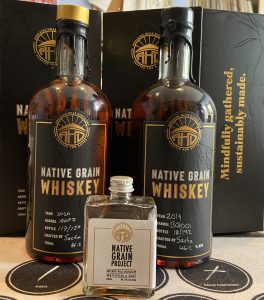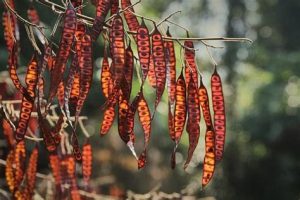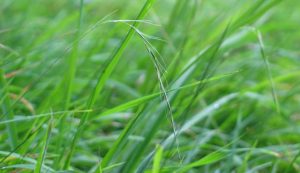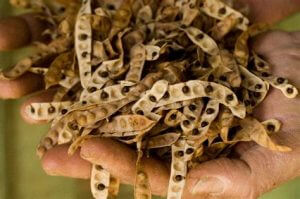Native Grains
Whisky is a cereal-based drink, but the majority is made from two types: corn and barley, with some wheat and rye also in the mix. What though of other cereal types? If heritage varieties are all the rage in food, what about using native grains in whisky?An Australian distiller has asked that very question
Every craft needs its avant-garde. It is there is food and fashion, music, art, and literature. Boundaries have to be tested, orthodoxies challenged, awkward questions asked, and feathers ruffled. Progress never comes from the mainstream, but from the fringes. It’s where deeper ideas are born.
One example of an avant-garde whisky sensibility came to my attention, thanks to a piece by Luke McCarthy about the Adelaide Hills Distillery’s native grains project [check out Luke’s essential website ozwhiskyreview.com.au]
It came about when Adelaide Hills’ distiller Sacha La Forgia asked the question, ‘what would be used if whisky was an Australian creation?’ It’s not that outrageous a [question] gentle reader. For centuries, distillers have used what grows around them: rice, agave, cane, grapes, apples, barley, rye, … Local conditions dictate the crop. Given that, Australian whisky would turn to its native grains.
‘Before colonial settlement, the Aboriginal people had established a grain belt through the middle of the country,’ La Forgia explains. ‘Why try and replicate the Europeans? There was plenty of European whisky available already, why make another?’

This approach is La Forgia is hardly new to this approach. He’s made Aussie vermouth, and amari as well as distilling green ants for a gin. Indeed, gin was a starting pint for this project.
‘When we started thinking about whisky shortly after releasing the gin we kind of took a gin-maker’s approach, using various sources to build flavour. Instead of botanicals we were using native grains.’
Spinifex, and kangaroo grass were trialed, but wattleseed [which grows in the centre of Australia in desert conditions] was the favourite. ‘If Australia was going to make a whiskey it seemed obvious that wattleseed would have been the preferred grain. Although 10 tonne is traded commercially here, there’s an immeasurable quantity that just falls on the ground every year.’

The first release was ‘Native Grain Project’, a mixed mash of malted barley and wattleseed aged for nine months in ex-Cab Franc casks. The same whisky, aged for over two years, then appeared as Native Grain Whiskey. [for tasting notes click here]
When I tasted it, the flavours were familiar but different. Oblique takes on things known. Of course they were. This was the aroma and taste of wattleseed. Why would it taste like barley? If it did, that would negate the whole process.
It was still fascinatingly, frustratingly, elusive. Identifiably whisky, but the spices were different. It had a dry toasted nuttiness, and a chocolate element which was more like carob or pure cacao. A lift came from a citric element then there were subtle background fruits which spoke of the orchard.
The process of trying to get my head around it reminded me of my amiga Sophie seeing my puzzled face when we were tasting tequila. ‘I’m trying to work out what agave tastes like.’ I explained.
‘Dave,’ she said, ‘agave tastes of agave.’
So wattleseed tastes of wattleseed. We can get close to it, but ultimately it is what it is.
‘I like that!’ says La Forgia when I tell him. ‘That chocolate carob thing? That’s the seed. Common descriptors are that, also nuts, coco, stone fruit, trail mix, and coffee, but there’s also also fruity, peach, apricot characters.’

That dry nutty cacao quality comes from the handling of the seed which has to be roasted before it can be eaten. Also, as roasting removes toxic elements, it’s a wise move.
’We played with it like coffee,’ says La Forgia. ‘A light roast (16 and a half to 17 minutes) was chosen to preserve the fruitiness as well as touches of carob and nuts. The more you roast the more you get burnt, coco, and coffee. I like keeping the fruity characters.’
No sooner was the Native Grain released than he ran into problems. It transpires that wattleseed’s a pseudocereal like quinoa, amaranth, and buckwheat and therefore according to the Australian Distillers Association not a true cereal. It couldn’t be used in a whisky.
[This hasn’t stopped other distillers using pseudocereals. Eddu from Distillerie des Menhirs in Brittany is made from buckwheat, Corsair in Kentucky/Tennessee has made quinoa-based whiskey and Buffalo Trace has used amaranth for its Col. E.H. Taylor ‘Grain of the Gods’.]

Undaunted, La Forgia looked at other native grains finally deciding, appropriately enough, on weeping grass.
‘It was great for a few reasons. It grows prolifically and perennially so you can actually harvest three to five crops a year without the need to ever remove and re-sow.’
While the resulting whisky [link] shares some of the roasted nuttiness of wattleseed there’s more soft fruits and a dusty spiciness. As with the wattleseed, only a small amount was needed to give this effect – used like a speciality malt in a beer.
The surprise for me was the choice of red wine casks for maturation. Wasn’t he scared of them dominating the grains’ character? ‘My background is winemaking, so I learned that wine oak is really, really high quality. Being in the middle of a wine region, and wanting to make sure I only used the best oak, ex-wine seemed like the best choice!
‘I was a little concerned about dominance, but I only wanted old casks and French oak wine casks have a finer grain than what would normally be used for spirits, so I made a bit of an educated guess. The casks came from a university friend who was actually running the winery next door to the distillery.’

The cask gives the weeping grass whisky lush, ripe, red fruits and while the wattleseed has a surprising amount of popcorn and butterscotch, neither are drowned – or too vinous. Instead, the fruits act as a binding agent.
For La Forgia this is just the start. ‘The long-term plan is to make a 100% Australian grain whiskey,’ he says. ‘It is just not possible at the moment given the prices, but in another 15 years and we will be doing it.’
It makes sense, not just in terms of widening the flavour profile, and creating an Australian signature, but makes sense from a sustainability point of view as native grains can be cultivated without need for irrigation or fertiliser.
‘Australia could be incredibly sustainable if we were to embrace the crops that grow in our conditions,’ he says. ‘We can show how inherently sustainable a lot of our native foods are.
‘When I was a kid I was told stories of brave explorers trying to traverse the country, and how many died of starvation in the harsh and arid environment. Turns out they were starving to death while surrounded by bountiful food!’
The thinking coming from the fringes can give pointers to a different future. Could that happen here?